|
Great Britain awarded a number of its already existing
decorations for bravery or distinguished service during WW2 but also instituted a fair
amount of new awards. Only the latter are the subject of this page.
The George Cross
|
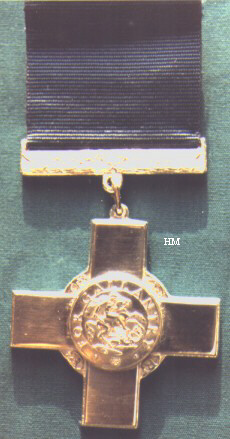
|
Instituted on 24 September 1940, this
award was intended to reward only acts of the greatest heroism or of the most conspicuous
courage in extreme danger and was primarily intended to be bestowed on civilians. Military
personnel (including the Home Guard) could only receive it for actions where military
honours were not normally granted. The George Cross ranks immediately after Britain's
highest decoration, the Victoria Cross, and before all other orders, decorations and
medals. Subsequent awards are indicated by a bar on its ribbon. |
The George Medal
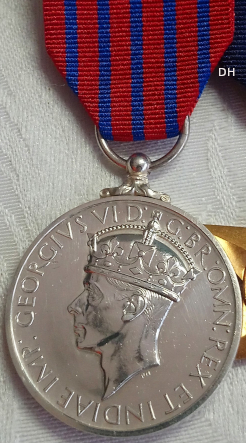 |
|  |
Instituted on the same day as the
George Cross, this medal was awarded under the same criteria but for lesser acts of
heroism or courage. It ranks after the Conspicuous Gallantry and Distinguished Conduct
Medals.
|
The Conspicuous
Gallantry Medal (Flying)
The awarding of the Conspicuous
Gallantry Medal was extended to Warrant Officers, NCOs and men of the air forces of Great
Britain and the Commonwealth on 10 November 1942. The medal itself is identical to its
already existing naval counterpart but hangs from a different ribbon : pale blue with dark
blue edges.
The Stars for
1939-1945

Nine campaign stars were created for
the 2nd World War but the maximum any individual can wear is five. A number of bars were
also instituted but only one could be worn on any one of the stars. The criteria for award
and the dates, services, areas and exceptions concerned are quite elaborate and
complicated and would fill several pages, so only the main details are given below.
The reverse of these stars is blank (except for the naming on stars and medals to Australians and South Africans)
THE 1939-1945 STAR
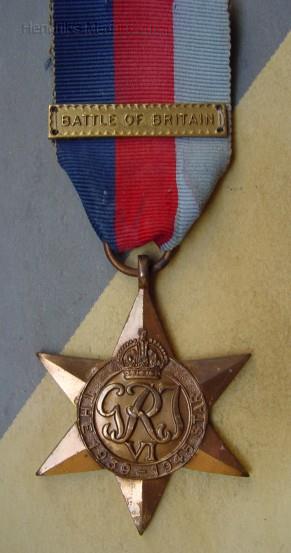 |
Mainly awarded for a minimum of 180
days operational service between 3 September 1939 and 2 September 1945 (60 days for RAF in
an operation unit engaged in operations against the enemy).
A bar "BATTLE OF BRITAIN" was authorised for fighter aircraft crew that
participated in this battle between 10 July and 31 October 1940.
More recently, in 2012, a bar "BOMBER COMMAND" was
instituted to recognise those who between 3 September 1939 and 8 May 1945 either served as aircrew on a Bomber Command
operational unit for at least 60 days and flew minimum one operational sortie.
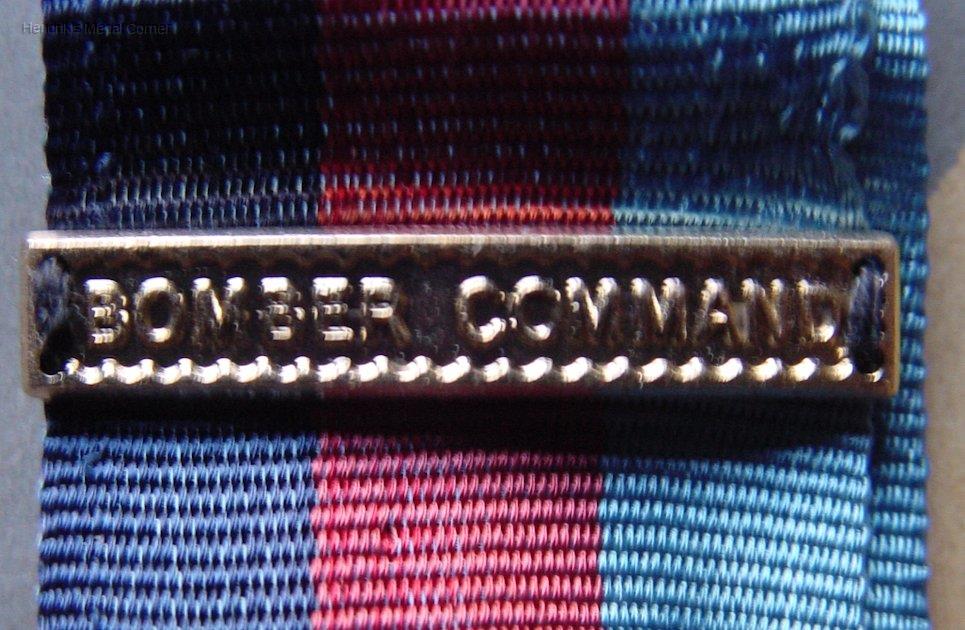
The ribbon colours symbolize the Royal
and Merchant Navies (dark blue), the Army (red) and the Royal Air Force (pale blue). |
THE ATLANTIC STAR
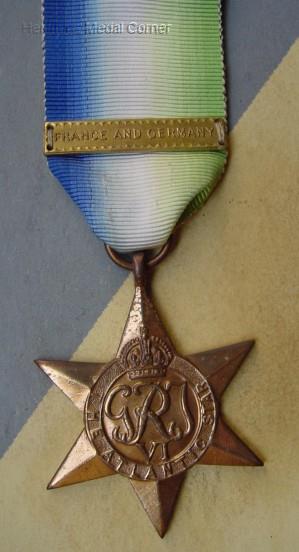 |
Generally awarded for a minimum of 180
days service afloat between 3 September 1939 and 2 September 1945 (60 days for RAF), this
star served to commemorate the Battle of the Atlantic. However, the qualifying period only
started from the moment the 1939-1945 Star had been earned.
Bars "AIR CREW EUROPE" and "FRANCE AND GERMANY" were created to be added in case the recipient subsequently
qualified for those stars (a maximum of one bar only can be worn !).
The ribbon colours
are symbolical of the Atlantic Ocean's waters throughout the seasons. |
THE AIR CREW EUROPE STAR
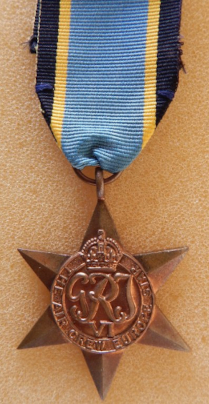 |
This star was awarded for operational
flying from UK bases over Europe between 3 September 1939 and 5 June 1944. Once again, the
criteria for the 1939-1945 Star had to be fulfilled first before the qualifying period
started. Thus this qualifying period was set at 120 days serving as a member of an air
crew in an operational unit i.e. two months for the 1939-1945 Star and a further two months
to obtain the Air Crew Europe Star.
Bars "ATLANTIC"
and "FRANCE AND GERMANY" were created to be added in case the
recipient subsequently qualified for those stars (a maximum of one bar only can be worn
!).
The ribbon colours represent the air force (pale blue) and its day and night continous
service (yellow and black). |
THE AFRICA STAR
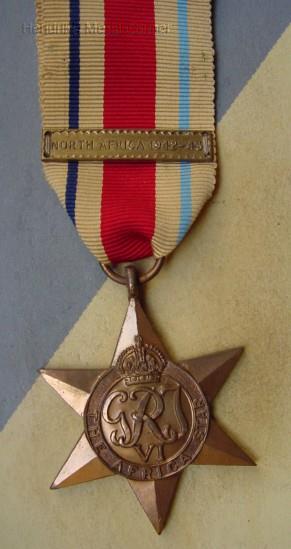 |
No prior award of the 1939-1945 Star is
necessary for this star which was awarded for one or more day's service in North Africa
between 10 June 1940 and 12 May 1943.
Three bars (of which only the first awarded can be
worn) were instituted : "EIGHT
ARMY", "FIRST ARMY" and "NORTH
AFRICA 1942-43". Service with
the 8th Army between 23 October 1942 (Battle of El Alamein) and 12 May 1943 and service
with the 1st Army between 8 November and 12 May 1943 qualified one for the first two of
these bars. Service between 23 October 1942 and 12 May 1943 for those outside of both
these armies (i.e. personnel of the 18th Army Group HQ, naval and air force personnel,
merchant navy members etc.) was the qualification for the final of the above bars.
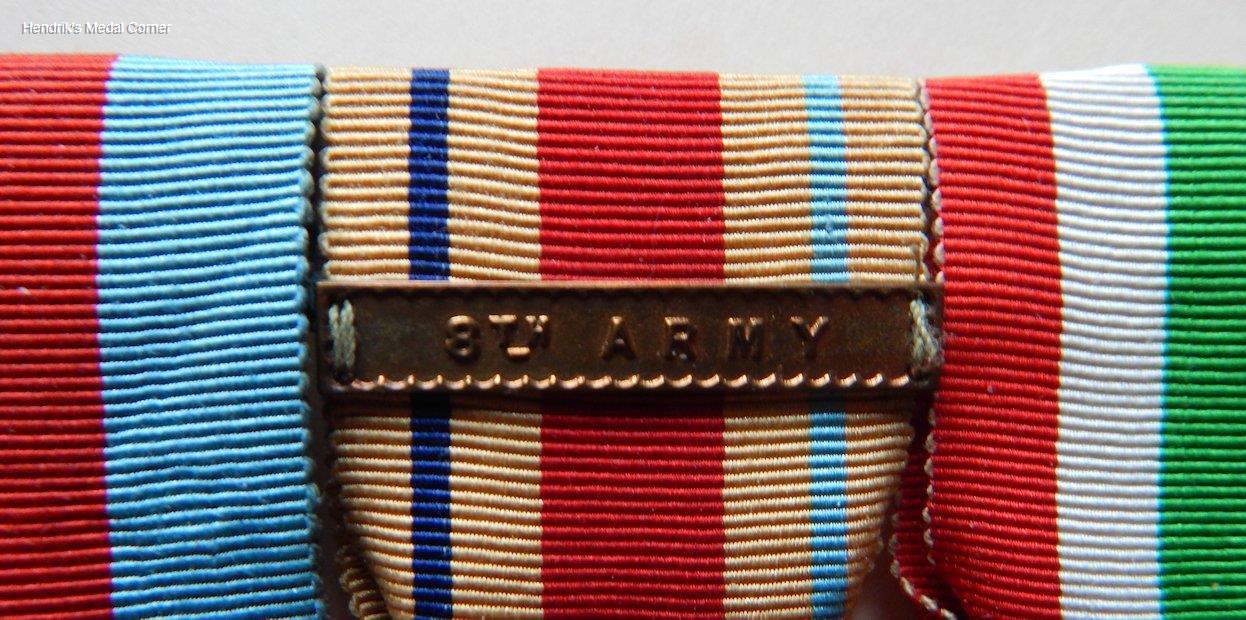
The
ribbon colours represent the desert and the colours of the Royal Navy, Army and RAF. |
THE PACIFIC STAR
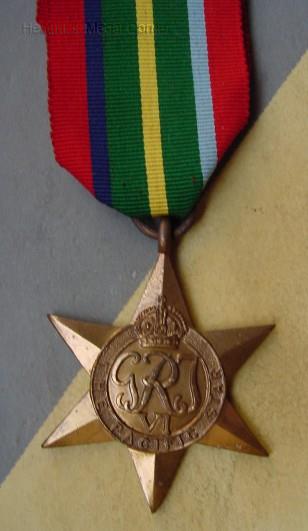 |
Service between 8 December 1941 and 2
September 1945 in the Pacific theatre of operations was the requirement for this star
(although, for Navy and Merchant Marine personnel, the 1939-1945 Star had to be earned
first).
When the recipient later also qualified for the Burma Star, a bar "BURMA" was worn.
The ribbon colours represent the jungles and beaches
(green and yellow) and the armed forces (dark blue for the Royal Navy, red for the Royal
Army and pale blue for the Royal Air Force). |
THE BURMA STAR
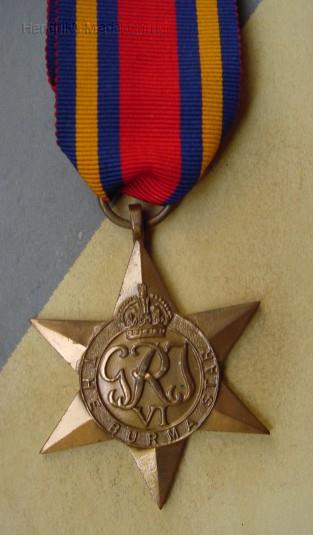 |
After qualifying for the 1939-1945
Star, service in the area between 11 December 1941 and 2 September 1945 was the criterion
for this star.
Subsequent qualification for the Pacific Star led to a bar "PACIFIC" being worn.
The ribbon colours represent the British and
Commonwealth armed forces (blue and red) and the sun (orange). |
THE ITALY STAR
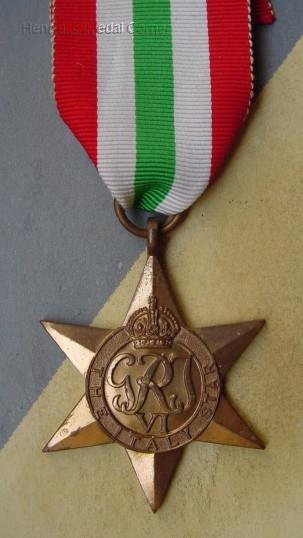 |
Operational service in Sicily or Italy
between 11 June 1943 (capture of the island of Pantellaria) and 8 May 1945 was the main
criterion for this star. However, service elsewhere in the Mediterranean, the Aegean,
Dodecanese, Corsica, Greece, Sardinia, Yugoslavia, Elba and indeed even the entry into
Austrian territory in the later stages of the war could serve to qualify although for some
of these areas time limits were set.
The Italy Star was always awarded in addition to
other stars so that no bars were instituted for it. Only Royal Navy and Merchant Navy
personnel had to qualify for the 1939-1945 Star first; this prior time qualification was
not necessary for the other services.
The ribbon colours represent the national colours of
Italy. |
THE FRANCE AND GERMANY STAR
 |
This star was awarded for operational
service in France, Belgium, Holland, Luxembourg or Germany between D-Day and the German
surrender, i.e. between 6 June 1944 and 8 May 1945.
Prior qualification for the 1939-1945
Star was not required and a subsequent fulfilling of the criteria for the Atlantic Star
was denoted by a bar "ATLANTIC".
The ribbon colours, besides being those
of the Union Jack, represent the national colours of France, Holland and Luxembourg ...
little Belgium seems to have been forgotten ! |
THE ARTIC STAR
 |
Created as late as 2012, this star is awarded
for operational service of any length north of the Arctic Circle from 3 September 1939 to the 8 May 1945 inclusive.
It is primarily intended to commemorate service in the Arctic Convoys on board the ships of the convoys to North Russia
and their escorts.
The ribbon colours seem to symbolize the Royal and Merchant Navies (dark blue), the Army (red), the Royal Air Force (pale blue) and the Artic itself (white). |
The Defence
Medal
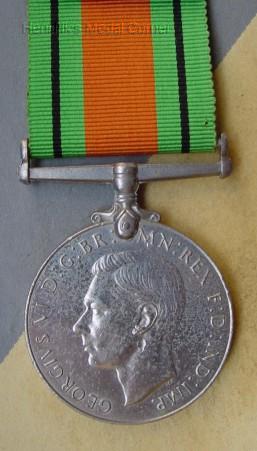 |
| 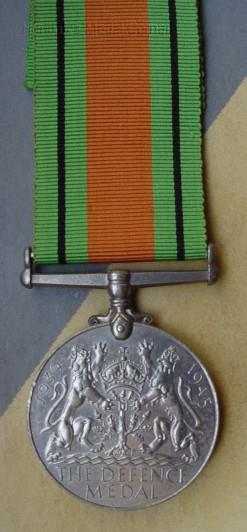 |
Various criteria and rules apply for
this medal's award also, the main one is service in non-operational areas subjected to air
attack or closely threatened for a minimum three years. The ribbon colours are symbolic of
the enemy attacks (flame colour) on the (green) British Isles whereas the black stripes
stand for the black-out during the war years. |
The War Medal
1939-1945
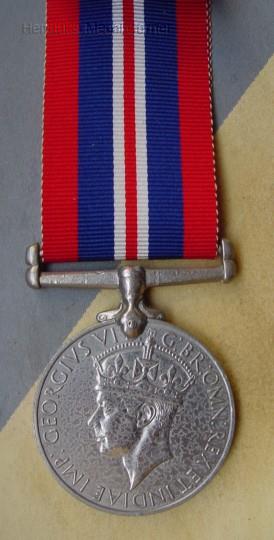 |
| 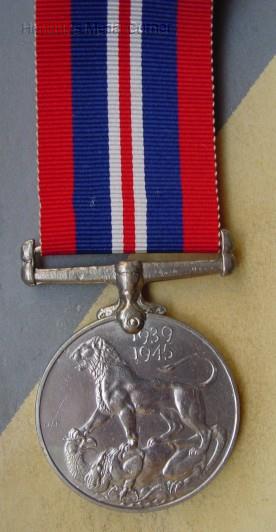 |
A minimum of 28 days of service,
whether operational or non-operational, in the Armed Forces (including the Merchant Navy
when served at sea) sufficed for this medal.
The ribbon colours represent the Union Jack.
Servicemen who had received a Mention in Despatches or the King's Commendation for Bravery
wore a bronze oakleaf on this medal's ribbon. |
The King's
Commendation for Brave Conduct
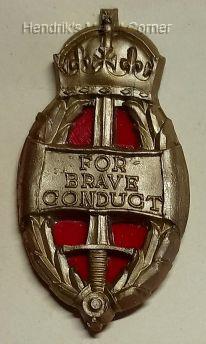 |
| Instituted in 1943 for award to
civilians who had received a "Commendation for Brave Conduct". Gold coloured
plastic badge with a red background consisting of an oval laurel wreath with an upraised
sword in it and a crown above. In the centre is a panel with "FOR BRAVE CONDUCT". This badge was later replaced by a silver laurel
spray to be worn on the Defence Medal's ribbon (or directly on the recipient's coat if he
had not qualified for the medal). |
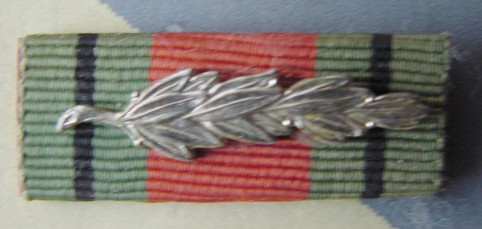 |
The King's
Commendation for Valuable Service in the Air
 |
Instituted in September 1945 for award
to civilians that had received this commendation. Silver badge, shield shaped and
consisting of a pair of stylised wings with a crown above and with a band at the top in
which is the text "FOR
VALUABLE SERVICES |
The King's Medal
for Courage in the Cause of Freedom
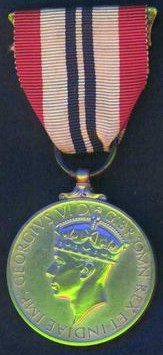 |
| 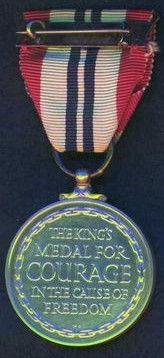 |
Instituted in August 1945 this medal
was destined for award mainly to allied civilians or other foreigners to recognize their
courage and risking torture or death in helping British service personnel to escape from
the enemy or for other dangerous activities in the interest of the British or allied cause
and which required exceptional courage. |
The King's Medal
for Service in the Cause of Freedom
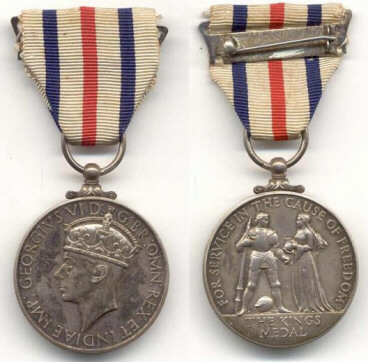 |
| Instituted together with the previous
medal, it was awarded for civilian services where the element of danger was less likely to
arise. Same obverse but the reverse shows a knight being offered food and drink by a
woman. The surrounding legend says "FOR SERVICE IN THE CAUSE OF FREEDOM" and in the exergue is "THE KING'S / MEDAL". The ribbon
is white with three equally spaced stripes of blue-red-blue at the edges. |
 to TOP
to TOP
COMMONWEALTH AWARDS
The Australia Service Medal
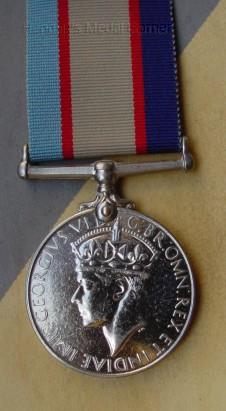 |
| 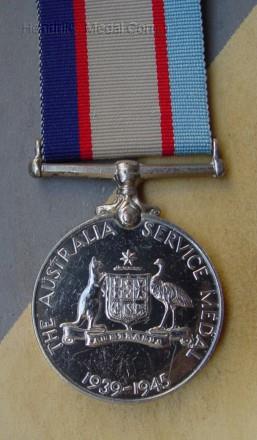 |
Instituted in 1949 and awarded to the
members of the Australian Armed Forces, Merchant Marine and civilians serving fulltime
overseas for at least 18 months (or 3 years part-time) between 3 September 1939 and 2
September 1945.
About 177,000 medals were issued.
In 1996, the required service period was
reduced to 30 and 90 days respectively. |
The Civilian Service Medal 1939-1945
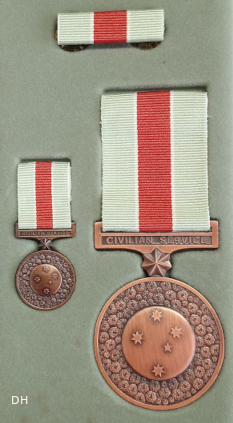 |
| This medal was instituted as late as 28 October 1994 for
award to civilians who served in arduous circumstances in support of the war effort between 3 September 1939 and 2 September 1945,
as part of organisations with military-like arrangements and conditions of service (e.g. the Australian Women's Land Army, the Civil Constructional Corps and the Red Cross Emergency Service Companies). |
The Order of Burma
This rare order is a long service award
but its date of institution, 10 May 1940, merits it to be mentioned here.
The Burma Gallantry Medal
This silver medal was awarded to
personnel of the Burma Armed Forces for conspicuous gallantry and instituted on 10 May
1940. The obverse has the crowned head of George VI while on the reverse is the text
"FOR GALLANTRY" in an open laurel wreath with "BURMA" on top. The
ribbon is dark green with a crimson centre stripe. A bar for multiple awards was also
created (three were awarded) and the medal fell into disuse on Burma's independence in
January 1948, at which time only 207 medals had been issued.
The Canadian Voluntary
Service Medal
 |
| 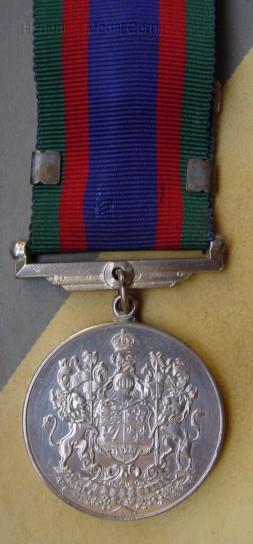 |
This silver medal was authorized in
1943 for award to all ranks of the Canadian Armed Forces who volunteered for service and
effectively served a minimum of 18 months during WW2 (between 2 September 1939 and 1 March
1947 if enlisted before 1 September 1945).
Serving abroad qualified for a maple leaf bar
and participation in the Dieppe raid also entailed the issue of a bar. A further bar
exists for service in Hong Kong between 8 and 25 December 1941. |
The Canadian Memorial Cross
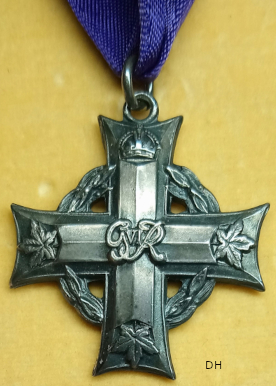 |
| Similar to the WW1 Memorial Cross, this
medal was instituted on 27 August 1940 for award to the next-of-kin of those that died
while on active service during the war. |
The Indian Recruiting Badge 1939-45
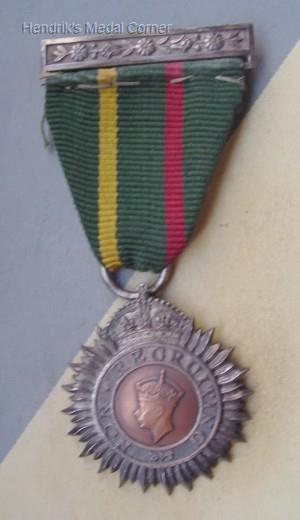 |
| This medal, created in 1940, was awarded to fulltime members
of the Indian Recruiting Organisation but also to fathers and mothers having at least 3 children in the armed forces and to
wives having a husband an at least 2 children serving in the defence forces.
The reverse is blank but for a serial number. |
The India Service Medal
1939-45
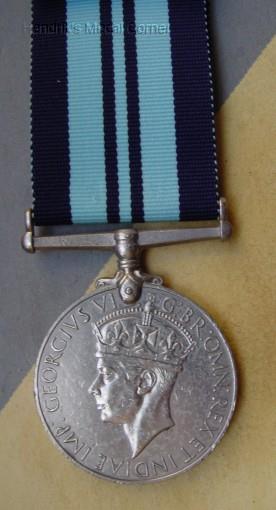 |
| 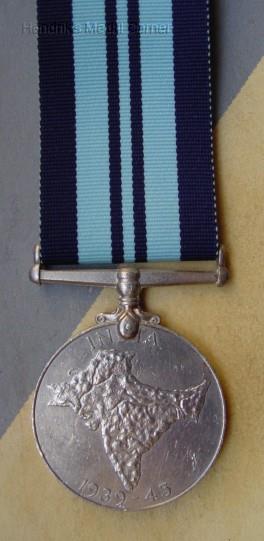 |
This medal, instituted on 6 June 1946,
was awarded for three years of non-operational service in the Indian Forces between 3
September 1939 and 2 September 1945 excluding those that were entitled to the British
Defence Medal.
Its ribbon colours represent those of the Order of the Star of India (light
blue) and the Order of the Indian Empire (dark blue).
Some 222,000 medals were awarded. |
The New Zealand War Service
Medal
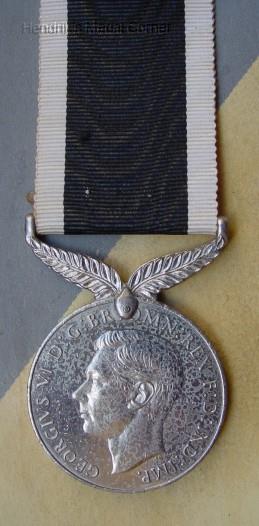 |
| 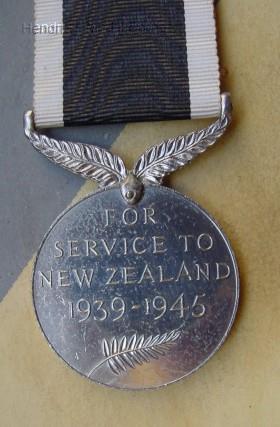 |
Awarded to the members of the New
Zealand Armed Forces (including e.g. the Home Army) and Merchant Marine who served an
aggregate of at least 28 days of full-time service or 6 months part-time.
Some 238,000
medals were struck. |
The Newfoundland Service
Medal
No doubt the rarest of the British WW2
awards, this medal was created as late as 14 July 1981 for award to any Newfoundlander
that had volunteered to serve in the British Imperial Forces during WW2. Awarded medals
are numbered.
The New Zealand Memorial Cross
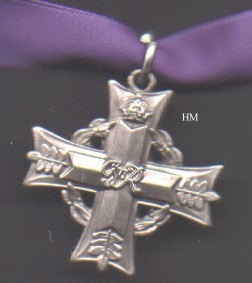 |
| Similar to the Canadian Memorial Cross,
this award was instituted in December 1946. |
The Africa Service Medal
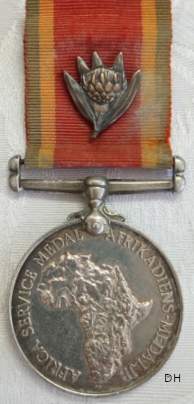 |
| 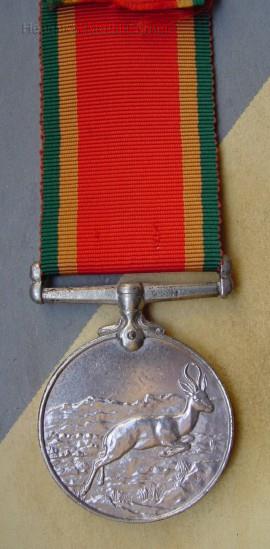 |
This silver medal was authorized on 16
November 1943 and awarded to those members of the South African forces (indeed for all
uniformed services of the country) who saw service in Africa before 13 May 1943, that
being the day that Africa was declared to be free of enemy forces.
A bronze Protea flower emblem was worn on the ribbon to denote a King's Commendation. |
The South Africa Medal for
War Services
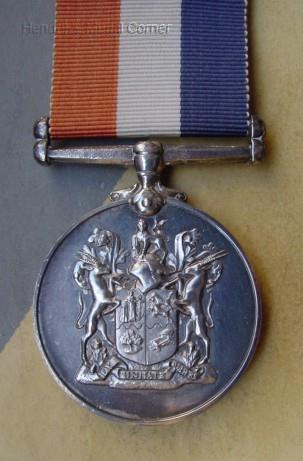 |
| 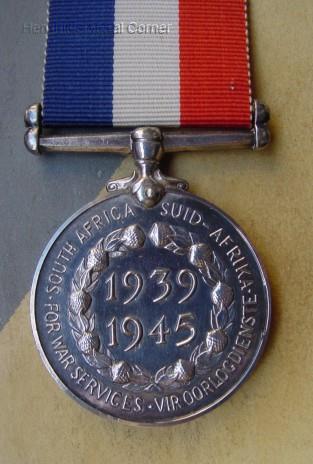 |
Created on 29 December 1946, this
silver medal was awarded to those who served for a minimum aggregate period of two years
(with at least one year of continuous service), between 6 September 1939 and 15 February
1946, in unpaid voluntary service in one of a number of recognized organisations (e.g. the
Red Cross of South Africa).
Approximately 17,000 of these medals were struck. |
The Southern Rhodesia
Service Medal
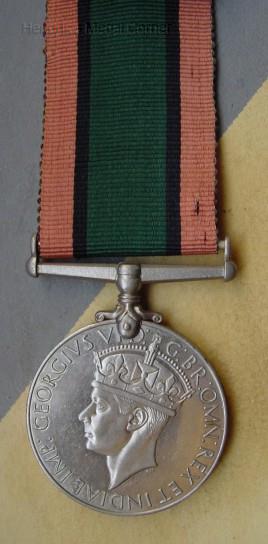 |
| 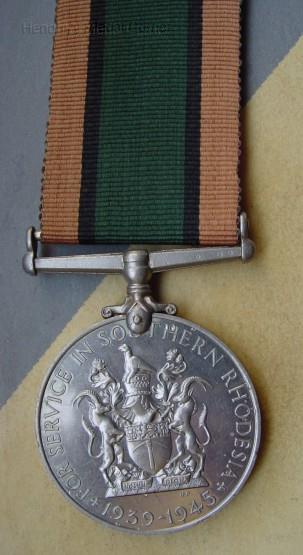 |
About 1,700 of this medal were awarded
to members of the Southern Rhodesia armed forces who served at home during the war. Anyone
that qualified for the UK War Medal or a campaign star was not entitled to receive this
medal as well. As most of these servicemen served overseas, this accounts for the low
number of medals issued. |
 to Medals' Corner Main Page
to Medals' Corner Main Page
Copyright Hendrik Meersschaert 2024 ©
|
